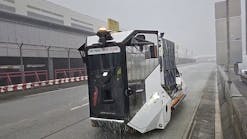The handling of pharma cargo and perishable goods took on an increased significance with the onset of the COVID-19 pandemic. Nearly two years later, the role this crucial cargo plays has only grown as the pandemic lingers and supply chains tighten.
“The supply chain has been subject to increased attention, reduced capacity and extreme challenges. This required increased communication and coordination among stakeholders, advanced planning, and is what, for example, made the COVID-19 vaccination program the most successful logistical operation of its kind,” says Ronald Schaefer, senior principal, IATA Consulting Americas.
The pandemic made it evident how important it is to have a good quality management program in place for the shipping of pharmaceuticals, Schaefer says.
“Companies with a CEIV Pharma certification were well-prepared to handle these sensitive products by ensuring availability of temperature-controlled facilities and equipment as well as maximizing the use or repurposing of existing infrastructure and minimizing temporary builds. In addition, availability of staff trained to handle time- and temperature-sensitive vaccines and installing robust monitoring capabilities ensured that the integrity of the vaccines was maintained,” he adds.
At the onset of the pandemic, when there were indications of large-scale temperature-sensitive vaccines being moved as air freight, John Dowds, VP service delivery – EMEAA, Worldwide Flight Services (WFS), says they initiated a systemic check of their cold storage and cargo capabilities.
“We initiated Project Coldstream as a coordinated evaluation of our capability for temperature control handling, looking at where we may need to increase our capacity and how we would procure contingency capacity if there were peaks of vaccine flow,” he says.
As it turned out, most vaccines would not be as temperature-sensitive as initially suspected, but WFS was ready for the task either way.
“It should be remembered that the pharma industry, airlines and handlers like WFS already had very resilient handling and transportation solutions for pharma shipments long before the COVID outbreak. Pharma has been an increasingly important product for our airline customers in recent years, and we have invested significantly in training, processes, equipment and facilities to support this growth in pharma volumes and to ensure the capacity to meet our customers’ service requirements,” Dowds says.
Wilson Kwong, Hactl chief executive, says when the pandemic hit, Hactl was already fully skilled, resourced, accredited and ready for the handling of pharma and perishables. This meant COVID-19 did not change their working methods or require any additional preparations.
“The challenges were the more general industry issues of staff absenteeism through compliance with quarantine regulations, governing staff who have tested positive and their respective close contacts, which are very strict in Hong Kong; and the dramatic cutbacks in scheduled passenger services, which reduced bellyhold capacity to a fraction of the normal levels and led to an increase in scheduled and charter freighter services,” Kwong says.
Trained for Resilience
As noted by Schaefer and demonstrated by WFS and Hactl, having a strong foundation based on the right training, requirements and technology to handle perishable goods has gone a long way to weathering the worst of COVID-19.
The IATA CEIV standards for both fresh and pharmaceutical goods govern the handling processes of different types of perishable goods. There are similarities between the two CEIV standards, notes Sonia Ben Hamida, head special cargo, IATA, but the requirements differ from commodity to commodity, adding a layer of complexity.
“Pharmaceutical products are often more valuable and involve a larger packaging and refrigeration budget. They may have more stringent time and temperature requirements. And in some cases, these shipments may be considered dangerous goods because they use dry ice or cargo tracking devices containing lithium batteries. Dangerous goods require appropriate labels and markings,” says Hamida.
IATA has harmonized processes with the Temperature Control Regulations (TCR) and the Perishable Cargo Regulations (PCR), and Hamida adds that IATA has also developed the CEIV Certification Programs to address their good implementation.
“Temperature maintenance is essential throughout the entire supply chain for both perishables and pharma, as temperature ‘excursions’ outside the stipulated range can cause damage and reduce shelf life for perishables and - more seriously with some pharma shipments - reduce or destroy the product’s efficacy,” says Kwong.
The temperature ranges applicable to some pharma and most fresh produce are the same – 15-25 degrees C, often known as “controlled ambient,” says Kwong. Some pharma shipments require other temperatures – such as 2-8 degrees C, often referred to as “refrigerated” or minus 15-minus 25 degrees C, often called “frozen.”
To maintain these standards and ensure a product never goes outside of the threshold of safe temperature requires intense and serious training.
Dowds says that at WFS has their own Training Academy at the Paris Charles de Gaulle Airport (CDG), which has previously been identified by IATA as one of the world’s top five aviation training providers.
“For perishables, we provide a half-day initial training for any operations-based people handling these cargoes. This can be classroom and virtual training and aligns with the IATA Perishable regulations and standards. There are periodic refresher courses to ensure any new requirements are incorporated and the user stays familiar with the product and handling requirements.
“Pharma training is also aligned with IATA’s pharma regulations and standards. We are currently in the process of the latest revision of our pharma training course, which is expected to go live in Q2 this year. These courses are issued to all stations across our global network to provide consistent high quality training and awareness,” he says.
Kwong describes perishable and pharma handling training as an integral part of Hactl’s training for all ground handling staff on the ramp and in the terminal, ensuring that every shift has plentiful staff resources to accommodate these products.
“Hactl conducts its own staff training, using impressive resources including training suites occupying an entire floor of our office building, VR training and online training initiated during the current restrictions. Training is ongoing: refresher courses are run regularly to ensure up-to-date knowledge and compliance; this is enshrined in our CEIV operating manuals,” Kwong continues.
Temperature Technology
Of course, training alone doesn’t keep temperature-sensitive goods from perishing. The right technology needs to be in place to keep temperatures at the proper levels.
“Our pharma centers are equipped with temperature monitoring management systems with active alarms for any temperature deviations. This ensures that even in the rare event of a temperature room deviating from its required range, we have the processes and contingency to ensure the shipments aren’t adversely affected,” Dowds says.
He adds that a rollout of new mobile technology is allowing greater visibility and control throughout the process and ensuring real-time updates or change of status are communicated internally and to WFS’ customers.
“In Paris CDG, we also have a tailored solution of temperature-controlled dollies, which are used to transport pharma shipments to the aircraft. This allows us to continue our temperature protection until the point of loading on the aircraft. Similar solutions are being evaluated in markets where we provide the airside transportation to aircraft,” he adds.
Kwong says technology is helping with the maintenance of temperature, with remote monitoring of containers and shipments – but stresses it is no substitute for active measures and procedures.
“CEIV Pharma and Fresh have been very helpful in creating a single standard for all parties, but prevention is better than a cure – and so Hactl has invested heavily in equipment and processes,” he says.
Hactl created a “Golden Route” fast-track through the ramp and terminal, designed to reduce the time taken from aircraft unloading to storage in controlled conditions, or hand-out to waiting customers. The Golden Route works alongside Hactl’s mobile app for customers, which enables them to pre-advise truck arrival and gain fast-track entry to its parking and truck bays.
“Unloading of aircraft and fast transfer to the terminal is assisted by mobile computing which enables our ramp team to input arriving cargo data and receive instructions on the go. These have all been proactive measures on the part of Hactl, designed to improve efficiency and quality of handling for all temperature-controlled cargo – with the aim of enabling our airline customers to fully capitalize on this lucrative revenue stream,” adds Kwong.
Prepping for the Future
While the pharma and perishable goods cargo industry has experienced little change from the COVID-19 pandemic, that doesn’t mean that the next challenge will be so kind.
With that in mind, Schaefer says to deal with future pandemics, it is advisable that companies shall on a continuous basis be focusing on:
- Forecasting vaccine and logistics needs: Determine equipment, supply and budget requirements needed to support deployment and vaccination operations based on the size of the population to be vaccinated.
- Assessing available storage capacity: Assess vaccine volumes and corresponding cold chain capacity per catchment area.
- Identifying surge capacity: Assess and map available cold chain capacities according to the three temperature ranges (e.g. +2 to +8 degrees C, -20 degrees C, and -70 degrees C) for storing the different types of COVID-19 vaccines under development. Include all available cold chain equipment outside the immunization program in the inventory and calculation of capacity.
- Planning for the security of vaccines and concerned staff: Clear security arrangements must be in place to ensure the safety and integrity of COVID-19 vaccines and ancillary products throughout the supply chain. Develop a plan to safeguard the security of all concerned staff and all vaccine storage facilities, including during transit.






